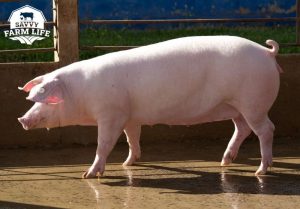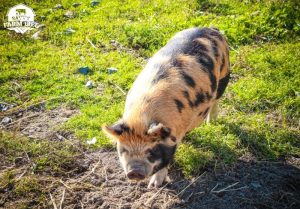Best Pig Breeds For Homesteads
You don’t have to have a large commercial operation to benefit from raising pigs. In fact, you can successfully raise a handful of pigs on just ¼ acre of land. If you have a simple homestead and are interested in raising pigs, you will want to know which breeds will provide the best fit for you.
Which pig breeds are best suited for homestead life? There are many wonderful pig breed options for the homestead, but some breeds offer more benefits than others for small-scale operations. In no specific order, our top 15 homestead breeds are:
- Yorkshire
- Red Wattle
- Tamworth
- Chester White
- Large Black
- Duroc
- Hampshire
- Kunekune
- Mangalitsa
- Berkshire
- Hereford
- Landrace
- Spotted
- Meishan
- Ossabaw
There are several reasons that you won’t find many self-sufficient homesteads without pigs – they can provide a significant amount of meat in a short time span, they are prolific breeders, and they are friendly and intelligent animals. As an added bonus, pigs are omnivores and can eat almost anything – including most of your kitchen scraps.
What Makes a Great Homestead Pig?
A good homestead pig should be of a friendly, docile breed. Most pigs are relatively easy-going (sows with piglets being a notable exception), but some breeds are mellower than others. Pigs are incredibly strong, and if you have a smaller operation it is even more important to raise a breed with a tame and manageable disposition.
A homestead pig will also be an excellent forager. Some breeds do best in confinement, while others are bred to get most of their nutrients from the land. Pigs are highly adaptable, and so many have evolved to thrive and gain weight on less intake than other commercial breeds.
While any breed of pig can thrive on the right homestead, you will want to know which breed will work best for your specific environment. Read on for more information on 15 of the best homestead pig breeds.
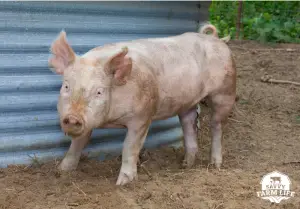
Homestead Pig #1: Yorkshire
The Yorkshire is the most popular commercial meat pig in the United States, but Yorkshires work just as well for small operations as they do for large ones. Yorkshires are a hardy breed and do well in most climates. They thrive in both confinement and on pasture.
Yorkshires are all-white pigs with erect ears. Females can reach 500-600 pounds, with boars maturing to 600-700 pounds. If raising Yorkshires (or any all-white pig), care must be taken to ensure shade is provided at all times – light-colored pigs are more prone to sunburn than their darker kin.
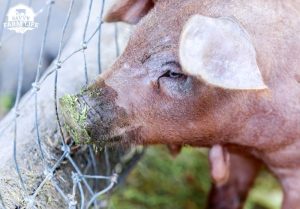
Homestead Pig #2: Red Wattle
Red Wattles do well on small homesteads, with their docile temperaments, ability to thrive in a variety of conditions, and the fact that they quickly reach a mature weight. Red Wattles are also excellent foragers and do well rotationally grazing on pasture.
As their name suggests, Red Wattles are reddish-brown in color and have distinct wattles hanging from their necks. Red Wattles are large hogs, with sows reaching 600-700 pounds and boars 700-800 pounds at maturity.
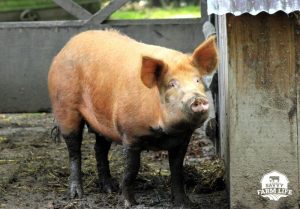
Homestead Pig #3: Tamworth
Tamworth pigs are especially good foragers and do particularly well in forested areas. Tamworths appreciate more space than some other breeds and do not do as well in confinement. Tamworth pigs are medium-sized at maturity, reaching a fully grown weight of 500-600 pounds on average.
Homestead Pig #4: Chester White
If you are looking to keep a breeding sow, you might look into the Chester White. They make excellent mothers, are prolific breeders, and are longer-lived than other breeds. Chester Whites average 600 (sows) and 700 (boars) pounds at maturity and are white in color with semi-erect ears. As is the case with other white pigs, like the Yorkshire, Chester Whites must have shade available at all times.
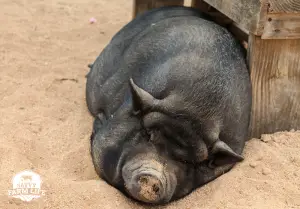
Homestead Pig #7: Large Black
The Large Black pig is a popular breed for those wanting to raise their pigs in a pasture. They are efficient producers of meat and able to gain most of their weight through foraging. As their name suggests, Large Blacks are solidly black in color and are, in fact, quite large. Sows mature at 600-700 pounds and boars mature at 700-800 pounds. They have floppy ears – often covering their eyes – which is common in breeds known to be excellent foragers.
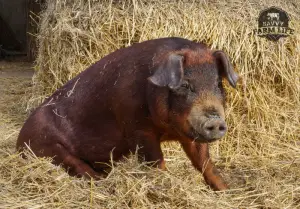
Homestead Pig #6: Duroc
Durocs are the second most popular breed in the United States and are excellent meat producers. These pigs are very docile and do especially well in colder climates due to their thicker skin. Many farmers in colder, Northern climates choose to raise Durocs because of their hardiness.
Durocs are solid-red in color and have floppy ears. They are heavy pigs, with sows reaching up to 700 pounds at maturity and boars reaching 800 pounds.
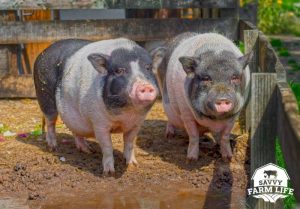
Homestead Pig #7: Hampshire
Hampshires are hardy pigs that thrive in a wide range of climates. They are also efficient foragers and meat producers. They are a medium-sized breed, maturing at between 500-650 pounds when fully grown, and are black in color with a white belt around their middles.
Homestead Pig #8: Kunekune
The Kunekune has been gaining popularity in recent years as a pasture pig breed. They are excellent foragers and as a smaller breed, they require far less supplemental feed than larger breeds. They are also friendly and outgoing – in fact, many consider the Kunekune to be the friendliest pig breed.
Kunekunes are colorful, often spotted, and can be quite hairy. They are one of the smaller breeds of pig – with sows averaging 150-200 pounds and boars averaging 250-300 pounds at maturity.
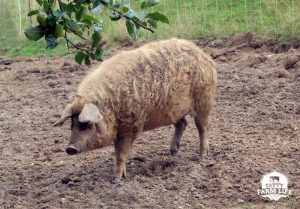
Homestead Pig #9: Mangalitsa
Mangalitsas are famous for their unique look, having curly hair similar in appearance to a sheep’s wool. While Mangalitsas are fun to look at, they hold their own in efficiency and foraging as well. They are excellent grazers, and they only need around half of the protein that a pig of another breed will require. Mangalitsas are a small-medium breed, maturing to 300-400 pounds. They come in three main colors – blond, red, and “swallow belly” (black with a white undercarriage).
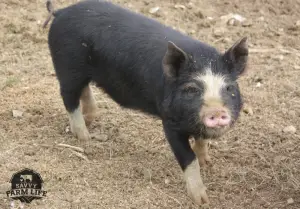
Homestead Pig #10: Berkshire
Berkshires are excellent foragers and efficient meat producers. They reach a market weight within 6 months of age and can get many of their nutrients from pasture alone. Berkshires have a black-and-white coloring and mature at 500-600 pounds.
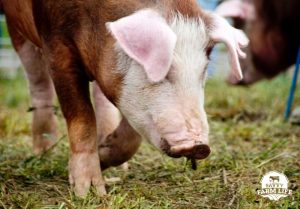
Homestead Pig #11: Hereford
Just like Hereford cattle, Hereford pigs have a unique appearance, having red bodies with white heads, legs, and bellies. Their looks and docile personalities make them popular with 4H and FFA students. They put weight on efficiently and on less grain than other breeds and reach market weight in only 5-6 months of life. Herefords are large hogs, reaching 600-800 pounds at maturity.
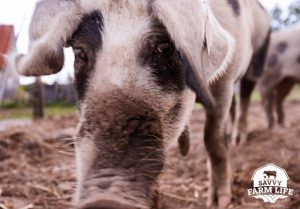
Homestead Pig #12: Landrace
The Landrace is another all-white (or pink) pig and is an excellent meat producer. They have longer bodies and therefore more back fat than other pigs, making them a popular bacon breed. Landraces are medium-sized hogs, with individuals topping out at between 450 and 600 pounds at maturity.
Homestead Pig #13: Spotted Pig
The Spotted pig is a fun breed to raise for its unique (spotted) coat. Spotted pigs are white with one or more black spots. They thrive on pasture, making them a good choice for a smaller homestead operation. Spotted Pigs are also excellent mothers, raising multiple large litters per year. These are medium-large pigs, maturing at between 500 and 600 pounds.
Homestead Pig #14: Meishan
Meishan pigs are slower to reach a mature weight than many other pig breeds, but they are worth mentioning due to their high level of sustainability. Meishans are known for having very large litters – farrowing and raising as many as 20 piglets at a time. They are excellent mothers and can have at least two large litters per year.
They have a unique appearance compared to other swine and are small-medium sized. Their average weight at maturity is 275-400 pounds. If your goal is to breed pigs and maintain a small, sustainable operation, the Meishan is worth looking into.
Homestead Pig #15: Ossabaw
Ossabaws are of a manageable size and considered small when compared to other breeds – they mature at only around 200 pounds. What makes the Ossabaw special is that they have lived for centuries in harsh conditions, evolving over the years with the ability to store fat and thrive even when food is scarce. Ossabaws are particularly good at foraging and do well in both pastured and forested environments. Ossabaws are closer in both behavior and appearance to their feral relatives yet friendly enough for the homestead.
Which Pig Breed Is Right For Your Homestead?
Pigs have been kept on homesteads for countless years and are one of the best livestock to raise in creating a sustainable way of living. They provide abundant meat and produce abundant offspring, making them the ideal animal for those wanting to provide for themselves. With so many different options available, there are likely multiple breeds that would be well-suited for your homestead. So, which one is right for you?
You can learn more about owning and raising pigs in my articles below, or find my latest articles here!

